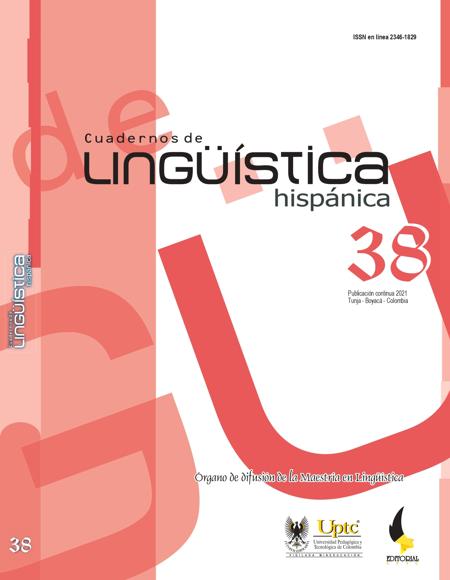Les marques de possession dans le wayunaiki

Résumé
L'objectif de cette étude est d'analyser et d'interpréter les marqueurs morphologiques qui font référence à la possession dans le contexte grammatical du nom, et de démontrer comment une structure possessive nominale est construite dans cette langue. L'analyse des données recueillies in situ a été faite dans la perspective de la linguistique descriptive (Himmelmann, 1998 ; Chelliah & De Reuse, 2011), qui comprend la collecte de données de source primaire, la détection de modeles réguliers sous-jacent le fonctionnement des aspects grammaticaux étudiés, et leur examen sur la base de catégories et d'une terminologie largement utilisées dans les travaux descriptifs. Dans le wayunaiki, une distinction est faite entre les marques de possession: les marques de possession inaliénable et les marques de possession aliénable. Dans la catégorie des inaliénables, il appartient les noms se référant aux parties du corps humain, les termes de parenté, les parties du corps des animaux, les parties des plantes, certains noms inanimés se référant à des choses étroitement liées aux humains. Morphologiquement, le wayunaiki traite différemment les noms inaliénables et aliénables
Mots-clés
wayunaiki, posesión, inalienable, alienable, marcas morfológicas, nombre, pronominal
Références
- Aikhenvald, A. Y. (2012). Possession and ownership: a cross linguistic perspective. Oxford: Oxford University Press. DOI: https://doi.org/10.1093/acprof:oso/9780199660223.003.0001
- Aikhenvald, A. Y. (2000). Classifiers. A typology of noun categorization devices, Oxford: Oxford University Press.
- Aikhenvald, A. Y. (1999). The arawak language family. The Amazonian languages, 65–106. Dixon R.M.W & A. Y. Aikhenvald (Eds.). Cambridge University Press.
- Bickel, Balthasar, Johanna Nichols (2013) Obligatory Possessive Inflection. In: Dryer, Matthew S. & Haspelmath, Martin (eds.) The World Atlas of Language Structures Online. Leipzig: Max Planck Institute for Evolutionary Anthropology.
- (Available online at http://wals.info/chapter/58, Accessed on 2018-06-07.)
- Chappell, H. & McGregor, W. (1996). Prolegomena to a theory of inalienability. In: Chappell, Hilary & McGregor, William (eds.) The grammar of inalienability, 3-30. Berlin: Mouton de Gruyter. DOI: https://doi.org/10.1515/9783110822137.3
- Chelliah, S. L. & Willem J. de Reuse (2011). Handbook of Descriptive Linguistic Fieldwork. Netherlands: Springer. DOI: https://doi.org/10.1007/978-90-481-9026-3
- Creissels, D. (2006). Syntaxe générale. En: Une introduction typologique. Vol. 1 y 2. Paris: Lavoisier.
- Dahl, Ö. & Koptjevskaja-T. M. (1998). Alienability splits and the grammaticalization of possessive constructions. In: Haukioja, Timo (ed.), Papers from the 16th Scandinavian Conference of Linguistics, 38-49. Turku: University of Turku.
- DANE Censo nacional de Población (2019); resultados preliminares.
- De Carvalho, F. (2016). The diachrony of person-number marking in the Lokono-wayuunaiki subgroup of the Arawak family. Language Sciences (55), 1–15 DOI: https://doi.org/10.1016/j.langsci.2016.02.001
- Dixon, R. M. W., and. Aikhenvald, A. Y. eds. (1999). The Amazonian Languages. (Cambridge Language Surveys.) Cambridge: Cambridge University Press.
- Dryer, Matthew S. (2013b) Coding of Nominal Plurality. In: Dryer, Matthew S. & Haspelmath, Martin (eds.) The World Atlas of Language Structures Online. Leipzig: Max Planck Institute for Evolutionary Anthropology. (Available online at http://wals.info/chapter/57, Accessed on 2018-06-06.)
- Dryer, M. (2007). Noun phrase structure. En: Thimothy Shopen (Ed.). Language Typology and syntactic Description Second edition Volume II: complex Constructions. Cambridge: Cambridge University Press DOI: https://doi.org/10.1017/CBO9780511619434.003
- Heine, B. (1997). Possession: cognitive forces, sources, and grammaticalization. Cambridge: CUP. DOI: https://doi.org/10.1017/CBO9780511581908
- Herslund, M. & Sørensen, F. (eds.) (2001). Dimensions of possession. Amsterdam: Benjamins, 201-225. Instituto Geográfico Agustín Codazzi (1986) La Guajira: aspectos geográficos. Bogotá: IGAC
- Koptjevskaja-., M. (1996). Possessive noun phrases in Maltese: Alienability, iconicity, and grammaticalization. Rivista di Linguistica 8.(1), 245-274.
- Lehmann, Christian. (1999). Possession in Yucatec Maya: Structures – functions – typology. Munich: Lincom Europa.
- Mansen, R. y Captain D. (2000) El idioma wayuu (o guajiro. María Stella González de Pérez y Mª L. Rodríguez de Montes (eds.) Lenguas indígenas de Colombia: una visión descriptiva: 795-810. Bogotá: Instituto Caro y Cuervo.
- Mansen, R. y Mansen, K. (1984). Aprendamos Guajiro. Gramática Pedagógica de Guajiro. Editorial Townsend, Bogotá, Colombia.
- McKay, G. R. (1996). Body parts, possession marking and nominal classes in Mosel, Ulrike. 2001. Linguistic Fieldwork. In International Encyclopedia of the Social and Behavioral Sciences, Vol. 13, ed. by Niel J. Smelser and Paul B. Baties, 8906–8910. DOI: https://doi.org/10.1016/B0-08-043076-7/03041-2
- Nichols, J. & Bickel, Balthasar. (2005). Possessive classification In: WALS, 242-245.
- Nichols, J. (1988). On alienable and inalienable possession. In: Shipley, William. (ed.) In honor of Mary Haas. Berlin: Mouton de Gruyter, 475-521. Noonan, DOI: https://doi.org/10.1515/9783110852387.557
- Olza, J. y Jusayú, M. A. (2012). Gramática de la lengua Guajira (morfosintaxis) 3ra edición modificas y aumentada. Universidad Católica Andrés Bello. Caracas: Montalbán La Vega.
- Ramírez, R. (1995). Morfología del verbo en Wayunaiki. Tesis de maestría en Etnolingüística. Universidad de los Andes. Bogotá
- Velazquez-Castillo, M.. (1996). The grammar of possession. Inalienability, incorporationand possessor ascension in Guaraní. Amsterdam: John Benjamins DOI: https://doi.org/10.1075/slcs.33
- Fishman, J. (1979). Sociología del lenguaje Madrid: Cátedra.
- Instituto Geográfico Agustín Codazzi (1986) La Guajira: aspectos geográficos. Bogotá: IGAC